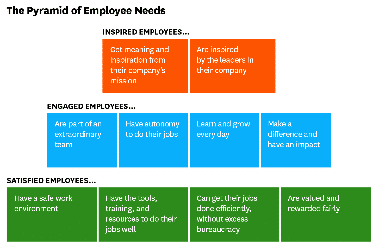Where has your journey taken you? What inspires you? The answers to these questions will help you craft and tell your own story, so you can share it with others. When you start sharing your story, you will begin to understand your impact on others and be able to identify who you need to inspire, as well as create a plan for doing it.
Take the story of Catherine Meloy, CEO, Goodwill Greater Washington, DC. Involved in several ministries with her father, Catherine was inspired at a very early age to help people. Growing up with a disciplinarian Marine father, and an unconditionally loving mother, shaped her identity.
Catherine considers discipline to be the number one attribute in business and the daily habit that helps her maintain focus. She believes that declaring your values and priorities as a leader creates greater accountability, and often asks herself, “What was really important a year ago?” or “What did I lose sleep over a month ago?” to help her stay focused on the big picture. She also believes that as a leader, “If you’re the smartest person in the room, you’re in the wrong room.”
A successful broadcasting executive of 20 years, she received a phone call one day requesting she serve as the leader of Goodwill. That call, along with her intelligence, commitment, and passion, has helped transform countless lives in the greater Washington community and beyond. In the debate of whether the heart or the head should prevail, Catherine uncompromisingly choses to lead with both. She credits her spiritual faith with impacting her leadership style and even the culture of Goodwill. She says, “Helping people to no longer need me is my goal.” Empowering people through education and training is what she does best – helping people learn to fish after being given the fish.
If you’re the smartest person in the room, you’re in the wrong room.
Catherine Meloy’s story is unique and inspirational. So is yours. As a leader, your story is important for many reasons. First, people relate to personal stories and see pieces of themselves in them. Second, they help people make connections—to you, to the organization, and to the mission. Your story helps you stay grounded in who you are and what you believe in. And lastly, others find inspiration in your story!
Take a few minutes to think about who has inspired you and how, both personally and professionally. Was it someone close to you or someone you’ve never met? Next, think about how those who have inspired you have influenced you as a leader.
Constructing your story
In developing your story, it’s important to understand who you are as a leader. To gain a better understanding of leadership style, think about:
- What inspires you?
- How did you receive this inspiration?
- What do you believe in/stand for?
- How did your life’s journey get you to this point?
Everyone has a story. Since you are the author of your story, you get to decide what’s important and the role you played in the story. Many stories have heroes, victims and villains, but you can rewrite your story by reframing how you feel about the events of your life, the role you’ve chosen to take and what motivated you forward.
It’s important to remember that others will learn from your story, and your story can have whatever ending you choose. Also, when you give people permission to write their own story, that is inspiring in itself.
What you value as a leader is important and also affects your story. What values have you developed? Here are some values and traits to think about:
- Authenticity
- Autonomy
- Connecting with people
- Customer service
- Diversity
- Efficiency
- Employee engagement
- Equality
- Leadership
- Justice/fairness
- Productivity
- Recognition
- Self-awareness
- Trust
- Teamwork/collaboration
At the end of this article, we’ve provided a worksheet that takes you through an exercise to construct your story. It will walk you through the following questions:
- What are your most important values?
- How do they merge with your mission?
- What inspires you?
- Where did you get this inspiration?
- How has your life’s journey led you to this place?
- What do you stand for?
Once you’ve completed the worksheet, identify the key points of your story and how this story led to inspiration. Also, consider what important values have emerged from your story.
Why is it important to identify your values and create a story? Among other reasons, a 2015 Bain & Company research study (EIU Research, 2015) surveyed 300 senior executives worldwide and assessed their impressions of employee output based on relative productivity. They divided the impressions into these categories: Dissatisfied, Satisfied, Engaged and Inspired.
Before we look at their findings, let’s review the definitions of the categories (from About.com):
Satisfaction — Contentment with one’s own work
Engagement — The willingness to offer discretionary work and energy to accomplish
work goals
Inspiration — Behaviors are driven by the meaning and purpose from the company’s mission
Productivity — Achievement toward one’s goals
You either walk inside your story and own it or You stand outside your story and hustle for your worthiness.
— Brené Brown
Below are graphical representations of their findings. Let’s take a look:

As you can see, productivity was lowest when workers were dissatisfied, unengaged, and uninspired. It was highest when employees were satisfied, engaged, and inspired. This is great information, but how can we use it to create a productive environment? To gain a better understanding, let’s take a look at Bain & Company’s Pyramid of Employee Needs.

Whom can you inspire?
The next step on the worksheet outlines how to take your story of inspiration to help you explore the following questions:
- Whom can you inspire? (Be specific)
- How can this person feel more connected
to you? - How can you help them feel more connected to the vision, mission, and values of the organization? Their job?
- How can you help them to understand how important their role is?
Ways to inspire
You’ve got your story, you know who you want to inspire, but how do you begin to apply your inspiration both internally and with others?
Here are some tactics for doing just that:
- Share your leadership story.
- Encourage others to “author” their own story.
- Help people to align their values to the mission
- Do the right thing … especially by people. Be a strong leader!
- Connect with people personally.
- Understand and “teach” your organization’s big picture and how each person is supporting it. (why are we all doing this?)
Help people see the “IMPORTANCE” of their role.

Take a some time over the next few days, weeks or months to think about and answer, “How is your story going to evolve?” and “How can I do more to inspire and be an inspiration to others?” Own your values, develop and share your story, and start inspiring yourself and others.
“Waiting for inspiration is another way of saying that you’re stalling. You don’t wait for inspiration, you command it to appear.”
About the authors
When it comes to identifying great leaders, Sherrie Barch believes that leaders are all around us and by recognizing patterns we can spot those who transform and inspire while avoiding the toxic, performance-draining ones. After sitting across from, both virtually and in person, more than 50,000 leaders in her career, she is energized by working with Boards and CEOs to find the right talent to move their organizations forward toward continued, long-lasting success. Legacy is built not by what we achieve, but through those we inspire to achieve.
Marsha King is a leadership expert and executive coach who works with senior leaders to assess their skills and personality, and to improve their overall performance and results. Most recently, she has coached executives within AMITA Healthcare, Astellas, Baxter, Takeda Pharmaceuticals, Rockwell Aerospace, iFLY, Kelton Research, KPMG, Shire Pharmaceuticals, PWC, Chick-fil-A and the Kellogg School of Management. Marsha is also a well-respected adjunct professor at Northwestern University and George Washington University where she teaches in the Human Resource Development programs, specializing in research.
Inspire and Invoke Action
How can we, men and women, continue to close the gender gap? What actions can we take to be the next generation of courageous leaders? See the compilation of articles and resources that will inspire your next step.

